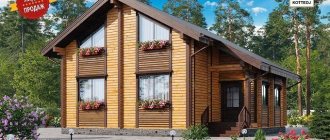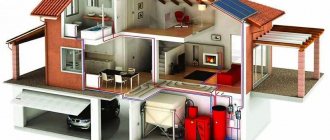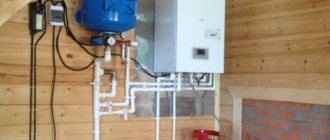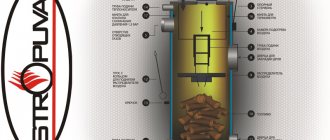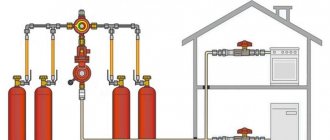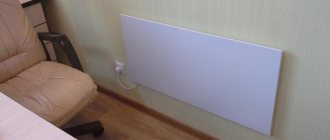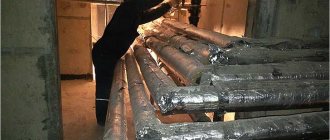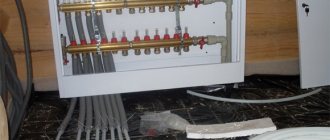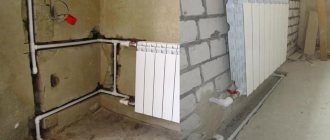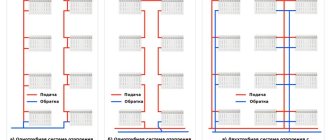It’s quite a common occurrence that when building a country house, the owners do not create any kind of detailed, “classical” heating system. The considerations are clear - during the very season of dacha life it is simply not needed, with the arrival of cool days - electric heaters come to the rescue. Well, when it gets really cold, dacha life freezes until spring comes, and the family moves to their heated city “residence.”
Is it possible to heat a house with heaters and how much does it cost?
But many dacha owners like to go there in the winter - on weekends or on the traditional long New Year and Christmas “vacations”. And a house that has stood without heating, even for a week, no matter how well it is insulated, will still get cold during this time. Will existing electric heaters help to quickly “breathe life” into a frozen dacha during a winter visit? Or, let’s put it another way: is it possible to heat a house with heaters and how much does it cost?
Spoiler alert: success is not guaranteed in all cases, and it comes at a high price.
Gas boilers
The water heating system is the most common for heating residential premises. Its meaning lies in the use of a coolant based on the circulation of water in the system.
It is often based on a gas boiler, which can be wall-mounted or floor-mounted. The wall-mounted boiler is a thermoblock that includes expansion and circulation pumps, a heat exchanger, and an automatic system.
Such boilers are double-circuit. The floor-standing boiler is single-circuit and includes a pump that supplies heated water to the heating system.
One of the important advantages of gas heating is ease of use and safety. Modern gas boilers are prudently equipped with an automation system that ensures safety, even in the event of flame extinction, and prevents gas leakage.
The disadvantages include:
- Long and labor-intensive registration of permission to use gas equipment.
- Allocation of a separate room for installation of a gas boiler, equipped in accordance with the requirements.
- The presence of a chimney and good ventilation.
- You must obtain permission from the fire inspectorate for installation.
Also, it should be taken into account that using gas boilers in a room of less than 100 square meters is unprofitable.
Electric boiler
Electric boilers are also used in water heating systems.
The principle of their operation is similar to that of a gas boiler, but operates using electricity. The advantages include:
- No chimney or separate room is required.
- Installation requires minimal documentation and does not take much time.
- Simple installation allows you to do without specialists.
Minuses:
- It is beneficial to use in small rooms , as the high cost of high energy consumption.
https://www.youtube.com/watch?v=2M_qMJoszUs
Blitz tips
- Using a pump in a heating circuit with an electrode heater increases the efficiency of the system by up to 20%.
- To connect an electric boiler, it is necessary to lay a separate line from the input distribution devices with subsequent grounding.
- To install electric boilers with a power of more than 10 kW, permission from energy supervision services is required.
- Heating a large room with one heater will not be effective , so several such devices should be installed simultaneously.
- It is not recommended to install heating devices near windows.
- Solar collectors usually serve as an auxiliary heating system, since they do not raise the temperature in the house to the optimal level in winter. Solar heating can be used as a primary system in regions where the sun shines at least 180 days a year.
Pellet boilers
Pellet boilers are becoming popular for use in heating systems.
The meaning of their work is to obtain energy by burning special granules - pellets . These pellets are made from sawdust, straw, and husks by pressing under pressure.
There are also peat pellets. Boilers using this type of solid fuel have a specific design and are designated as pellet.
They consist of the following parts:
- Enclosures with automation and connections to the heating circuit and chimney.
- A firebox with a heat exchanger and equipped with a chimney.
- Bunker for pellets.
- A mechanism that ensures the supply of pellets to the burner.
- Burners for pellets.
After the pellets enter the burner, they are ignited. This is usually achieved with the help of a small TEN and forced ventilation. The resulting heat from combustion of pellets heats the heat exchanger and the water in it. The water, in turn, begins to circulate through the heating system. Accordingly, such boilers are also used in water heating systems.
Principle of operation:
Principle of operation
The advantages of pellet boilers include:
- Possibility of high automation of the heating system. For example, using an electronic heating unit, you can set the selected operating mode for the desired period.
- Some types of pellet boilers are non-volatile , which is their advantage and allows you to save energy.
- fuel storage facilities
- When pellets are burned , virtually no ash or soot remains.
The disadvantages include:
- The cost of pellets is often high .
- A chimney is required.
- Ensuring control over the number of pellets in the bunker and adding them.
- Mandatory cleaning once a month.
- In addition, these boilers are floor-standing and take up a lot of space.
In general, water heating has a number of pros and cons. The advantages are - uniform heat distribution in relatively small rooms, the ability to limit the upper temperature limit.
An obvious disadvantage is the possibility of freezing water in the pipes and radiators of the heating system, which will inevitably lead to their damage after defrosting. High hydrostatic pressure and thermal inertia are also disadvantages.
The relationship between heat and heat loss
How much heat should a heated floor provide to heat a house? It depends on the heat loss of the house. But they always exist; there are no zero heat losses. Heat goes into the window and door structures, through the walls, and into the ceiling.
The better the house is insulated, the higher quality materials and advanced technologies were used, the less heat loss will be, and the higher the likelihood that the warm floor will be able to compensate for it in the cold season.
The amount of heat from the heated floor must be greater than or equal to heat loss.
The surface temperature of the heated floor should not exceed certain values. We have collected them in a table, indicating the regulatory document.
| Maximum permissible temperature | Purpose | Document |
| 26 degrees | For premises with permanent occupancy. | SP 60.13330.20212, clause 6.5.12. |
| 31 degrees | For rooms with temporary occupancy and pool bypass paths | SP 60.13330.20212, clause 6.5.12. |
| 35 degrees | temperature of the floor surface along the axis of the heating element in children's institutions, residential buildings and swimming pools | SP 60.13330.20212, clause 6.5.12. |
| No more than 10 degrees | temperature difference in individual areas of the floor | SP 41 -102-98 |
| 19-29 degrees | Floor surface temperature | According to the international standard ISO 7730 |
In practice, the surface of a heated floor is heated to 29 degrees in rooms with temporary occupancy, in bathrooms, etc.
Exceeding this temperature leads to serious and intractable vascular diseases of the legs.
Many people face this problem, including FORUMHOUSE user with the nickname Shurigin.
ShuriginFORUMHOUSE Member
The practical use of heated floors turned out to be not entirely comfortable. There is a feeling of swelling in the legs. In the bathroom, no matter where you go, you spend the least amount of time there, but in the kitchen this feeling is noticeably intensified.
Much depends on what material the flooring is made of. Calculations were carried out for completely identical rooms, but with different types of flooring. The types of coatings are listed in increasing order of the required surface temperature of the heated floor for room heating:
- parquet
- ceramic tile
- linoleum
- laminate
It is possible to create the heat flow necessary for heating, but heated floors have limitations that are not recommended to be exceeded.
Features of the operation of heat guns
This heating method is effective in large rooms where there is no permanent heating system.
Often, heat guns are used to heat industrial premises. The operating principle of this equipment is heat exchange between heated air and a heat gun. The supply of warm air is provided using a fan installed in the device or due to natural convection.
Heat generation is achieved by burning fuel - gas, kerosene, waste oil or hydrocarbon fuel. There are also electric heat guns.
Different methods of heat generation determine different models of heat guns.
Pros of heat guns:
- Equipped with a thermostat that allows the device to automatically turn on when the temperature drops.
- The protection system prevents overheating and will last a long time.
- The device is quite economical.
Minuses:
- Large dimensions of diesel and gas heat guns.
- Some types of these devices are not environmentally friendly
These types of heating devices include fan heaters. The principle of their operation is similar to a heat gun, but they are more compact in size and are designed to work in small spaces.
Heat generators
Heat generator “Bison”
The heat generator is a modified centrifugal pump. There are two types of heat generators - rotary and static. There are heat generators for air and water heating.
The principle of operation of a water heating heat generator is that the heated coolant is supplied by a pump to the heating devices. They release heat and lower the temperature of the coolant. Then, the coolant is returned back for subsequent heating. The coolant can be water or antifreeze.
An air heating generator works on the principle of a heat gun, heating the air and sending it through the ventilation ducts. They are used mainly in industrial, agricultural and warehouse premises.
Depending on the type of fuel, there are diesel, gas and solid fuel heat generators.
The disadvantages of most heat generators are noise, large size and too much power for small rooms.
Stove heating
There are two types of stove heating:
Regular traditional
It is heating through the use of released energy, which is achieved during the combustion process. This stove has a classic appearance with a firebox, chimney and ash collector. Such stoves heat only small rooms and take up a lot of space; they require constant addition of a combustion product (coal and wood), which are disadvantages.
Greater inertia, provision of a chimney and constant control of combustion can also be considered disadvantages. The advantages include: heating and cooking food using an oven, the ability to build it with your own hands, use in places where there is no gas or electricity, and the function of some room decor.
Water heating
Achieved by connecting a heat exchanger with a water circuit to the firebox of the stove , connected to a water heating system. A distinctive advantage from the previous type is the heating of large rooms.
Based on their functional features, stoves are divided into heating stoves, heating and cooking stoves, and fireplace stoves. They come in metal and brick.
https://www.youtube.com/watch?v=aB1duN9-N4c
Fireplace as a type of heating
There are several types of fireplaces:
- Built-in – fully equipped in the wall.
- Wall-mounted - most of them are hidden by an additionally constructed wall.
- Free-standing (island) . Such fireplaces are usually placed in the center of the room.
Based on the type of combustion part, fireplaces are divided into open and closed types. With one, two or three radiating surfaces. A cheaper option with one surface, and it also has higher heat transfer. A fireplace with three radiating surfaces is the most inefficient and expensive, but is considered more aesthetically pleasing and beautiful.
To achieve heating results with a fireplace, it must be built with two fireboxes, then the fireplace has the function of a stove.
The advantages of such heating include:
- Uniform and fast heating of the room.
- Long-term heat retention.
- Decorative function.
Minuses:
- They take up a lot of space , especially island fireplaces.
- The device requires the connection of professional workers.
- Possibility of precipitation entering through the chimney pipe.
There are also electric fireplaces that operate on electricity. Such fireplaces have several levels of heating, do not make noise, do not require a chimney, are a bright addition to the interior, but require a lot of energy consumption.
Don't forget to properly insulate your house
It is very important to choose and install the heating system correctly, but if the house is poorly insulated, everything will be in vain. No type of heating can effectively heat a room if the walls do not retain heat, so no less attention should be paid to thermal insulation.
Today the choice of thermal insulation materials is very large. If during the construction of a house it was not insulated enough, it will not be difficult to select additional insulation. Most often, stone wool, XPS boards made of extruded polystyrene foam or PIR thermal insulation based on polyisocyanurate foam are used for these purposes.
These materials have an extremely low thermal conductivity coefficient (the lower it is, the better), so even a thin layer of insulation significantly improves the thermal insulation properties of the structure.
Results
To summarize, it can be noted that gas-powered devices are the cheapest to operate. In second place in terms of cost are pellets. Coal and firewood are already more expensive fuels.
Electricity completes this list. When choosing equipment for heating a room, you need to weigh all factors, such as pricing, the possibility of self-installation, complexity of use, availability of free space, etc. With the right approach, you can create an alternative to other types of heating and get an economical and convenient heating system.
Natural gas
Natural gas, by default, is the leader among other types of fuel according to almost all proposed criteria. In many regions, the cost of 1 kWh produced by gas exceeds the same price tag for firewood by only 10-20%. The efficiency of the most budget and simple gas boilers is at least 90%. For high-tech models, for example, for condensing models, this figure is much higher and close to ideal.
In terms of convenience, gas is also a leader. There is no need to store it, or carry it to the boiler; the “loading” is done automatically. In terms of environmental friendliness (relatively, at the place of combustion), gas is in second place after electricity. Why it is conditional will become clear below.
Natural gas has only one drawback (if it has an adequate price in your region, of course) - availability. As mentioned above, not every new built house has a central highway. Even if it is very close, bringing gas from it to the house is not just an expensive undertaking, but very expensive. In some regions, the cost of connection may exceed the estimate for the construction of a full-fledged wooden house with an attic.
This is the conclusion regarding gas. If it is available in your area, you can afford its connection, and the price per cubic meter does not deter you, then this is what you need.
